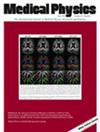Predicting early stage lung cancer recurrence and survival from combined tumor motion amplitude and radiomics on free-breathing 4D-CT
Abstract
Background
Cancer control outcomes of lung cancer are hypothesized to be affected by several confounding factors, including tumor heterogeneity and patient history, which have been hypothesized to mitigate the dose delivery effectiveness when treated with radiation therapy. Providing an accurate predictive model to identify patients at risk would enable tailored follow-up strategies during treatment.
Purpose
Our goal is to demonstrate the added prognostic value of including tumor displacement amplitude in a predictive model that combines clinical features and computed tomography (CT) radiomics for 2-year recurrence and survival in non-small-cell lung cancer (NSCLC) patients treated with curative-intent stereotactic body radiation therapy.
Methods
A cohort of 381 patients treated for primary lung cancer with radiotherapy was collected, each including a planning CT with a dosimetry plan, 4D-CT, and clinical information. From this cohort, 101 patients (26.5%) experienced cancer progression (locoregional/distant metastasis) or death within 2 years of the end of treatment. Imaging data was analyzed for radiomics features from the tumor segmented image, as well as tumor motion amplitude measured on 4D-CT. A random forest (RF) model was developed to predict the overall outcomes, which was compared to three other approaches — logistic regression, support vector machine, and convolutional neural networks.
Results
A 6-fold cross-validation study yielded an area under the receiver operating characteristic curve of 72% for progression-free survival when combining clinical data with radiomics features and tumor motion using a RF model (72% sensitivity and 81% specificity). The combined model showed significant improvement compared to standard clinical data. Model performances for loco-regional recurrence and overall survival sub-outcomes were established at 73% and 70%, respectively. No comparative methods reached statistical significance in any data configuration.
Conclusions
Combined tumor respiratory motion and radiomics features from planning CT showed promising predictive value for 2-year tumor control and survival, indicating the potential need for improving motion management strategies in future studies using machine learning-based prognosis models.


 求助内容:
求助内容: 应助结果提醒方式:
应助结果提醒方式:


